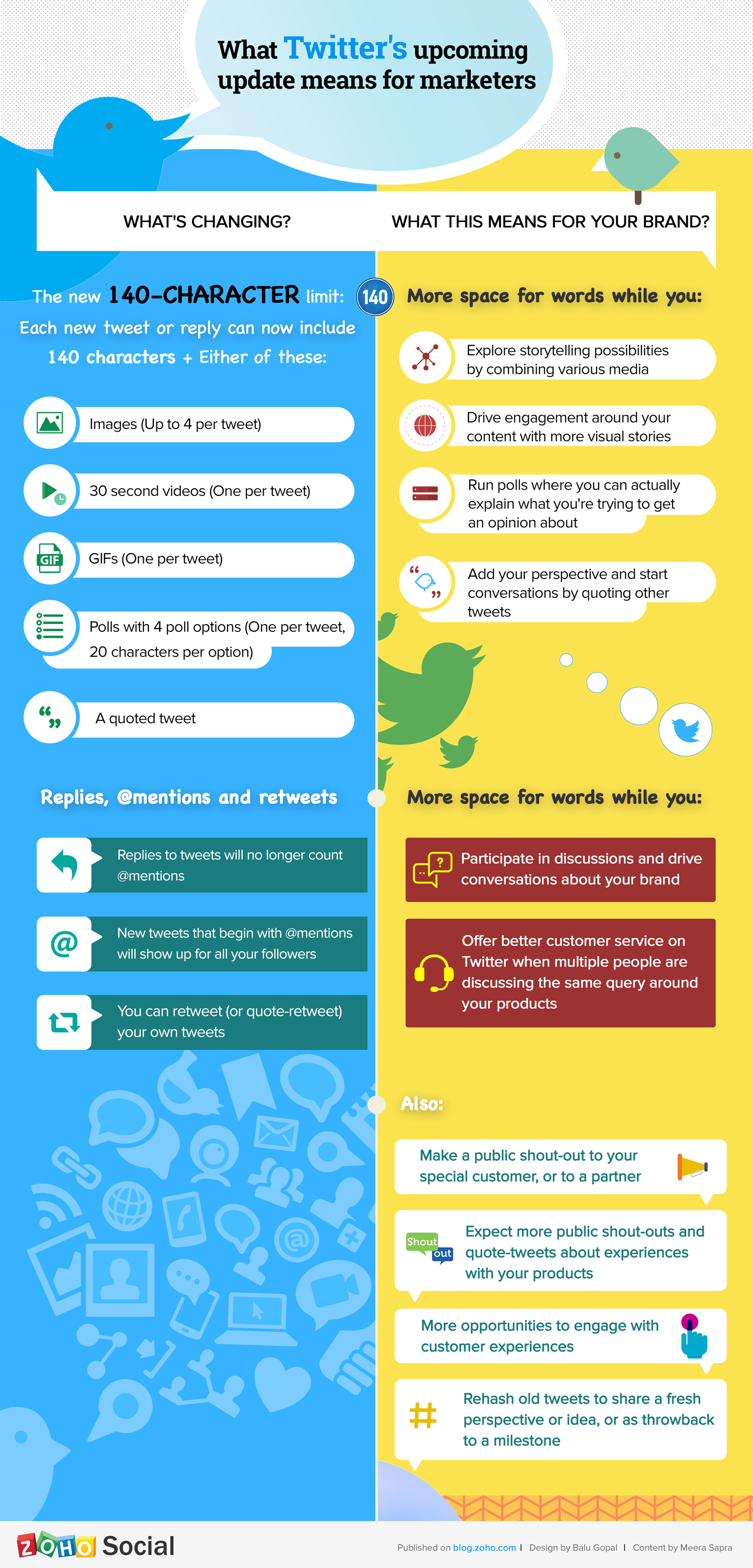.jpg)
But what do these changes really mean for your brand?
How can you, as a marketer use the new Twitter updates to build your brand on this platform?
Here's what we think:
What this means for brands: More media per tweet.
This is a HUGE change because it will help brands create and share media content without having to worry about fitting it all into the character limit.
Brand marketers already realize the importance of media in storytelling: over 65% of senior marketers believe that visuals are a core part of brand storytelling. During the last couple of years, we've seen Twitter emerge as a media-friendly platform – each tweet can currently include either of these:
up to 4 imagesa 30 second videoa pollor a GIFAccording to a recent report by Twitter, tweets with images can generate up to 313% more engagement than text-only tweets. Including media in your tweets also increases the chances of them being retweeted by about 35% for image tweets and 28% for video tweets.
With this update, Twitter will make it easier for marketers to tell stories and invite discussions around their brand, community or products using various media. For example, you'll be able to:
Tell a story using up to 4 images (with or without text on them) and still have 140 characters to write your tweet copy describing these imagesCreate a poll for your Twitter audience to participate in, using up to 140 characters for your poll question, and add up to 4 poll options to choose from (20 character limit for each poll option)Upload a 30 second video that tells a story and use up to 140 characters to talk about itQuote tweets from your customers or prospects and share your perspective about these using up to 140 charactersWhat this means for brands: Rehash your old tweets
Retweeting your own tweets sounds a bit narcissistic, but this might be a good way for brands to share previous tweets that went unnoticed. You could use this feature to add new thoughts to an older piece of content. Or, quote an older tweet as a throwback to an important milestone in your brand's journey from the past. And of course, we can probably expect some brands to quote their own tweets to issue "what-we-meant-when-we-said-this" tweet statements – to clarify any confusion over their previously unexplained stand about an issue.

What this means for brands: More interactive discussions and better customer service.
As a brand, you'll be able to reply to up to multiple Twitter handles in a single tweet and still have a 140 character limit left over for your content. This sounds like a promising change that can help you drive conversations and grow your community on Twitter.
For example, when two or more users are engaging in a conversation about your brand or discussing a piece of content that you've created, you can send out common replies to them without having to worry about fitting their handles into the 140 character limit – Twitter handles that pop up automatically when you hit reply won't count towards your character limit.
This could also help you offer better customer service on Twitter. For instance: If customer A tweets out to you with a question about your product or service and customer B replies to A's tweet saying they have the same question, you can now hit reply to send out a common 140 character response to customers A and B, and their handles won't count towards the 140 character limit.
What this means for brands: More public shout-outs, praise or criticism.
All tweets that begin with @mentions are currently only visible to people who follow both these Twitter handles – the handle they @mention as well as the author's handle. This has led to a lot of people using the .@mention convention whenever they want to make sure their tweet reaches everyone who's following them.
Tweets like these:
With the upcoming update, any new tweet that begins with an @mention will automatically be visible to everyone following the author's handle. This will negate the need for the .@mention. (There's no change to replies though – those will still be visible only to mutual followers on both handles.)
Since the original .@mention method was used to broadcast a tweet to all followers, people have been using it for tweets which say something they feel strongly about. By getting rid of the .@mention convention, Twitter's now making it easier for people to send public shout-outs to other people or brands. If you're a business owner or a brand marketer, you can expect to receive more public shout-outs whenever people experience strong positive or negative emotions towards your brand or your products. Be ready to face more bouquets and brickbats.
But hey, more engagement is always a good thing, and even negative tweets offer brands an opportunity to turn the situation around by opening up a conversation that addresses the customers' experience.
Another way that you can use this feature as a brand, is to send out a public shout-out to a special customer, or to another brand you're partnering with.
All-in-all, we're happy about the upcoming changes that Twitter is bringing in.
This post was originally published on the Zoho Blog
View the original article here
Original source: What Twitter's Upcoming Changes Mean for Marketers [Infographic].
http://www.jretechnology.com

No comments:
Post a Comment
Note: Only a member of this blog may post a comment.